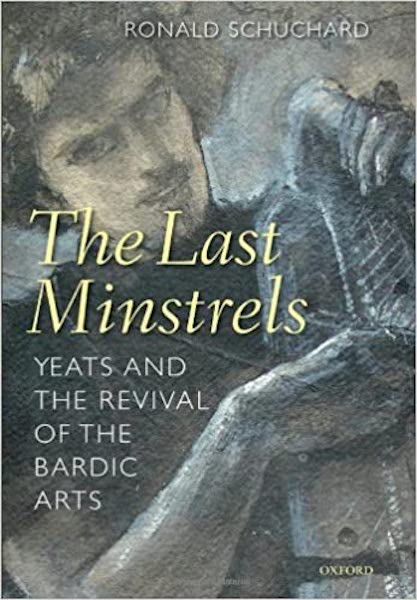This is a later version of a review originally published in English Studies Vol. 90, no. 5 (2009): 627-28.

In Ronald Schuchard’s sharply focused piece of literary biography and history, Yeats’s image gets just the kind of make-over that he himself would surely have wanted. Contemporary sources are comprehensively raided to prove that, far from merely posing as a bard in the Celtic twilight, the poet nurtured an earnest, active and long-term commitment "to return the poetic voice to the centre of culture" (xxi) – and not just his own national culture.
Schuchard demonstrates that Yeats’s concern with the poetic voice permeated his oeuvre, starting with the way he worked out his original inspiration. For example, Gretta Cousins, wife of the playwright James Cousins, described his whole "method of composing verse’ as ‘making a sound-scheme into which words were fitted after much trial and alteration" (274). His detailed instructions to those involved in reciting his work show how this "sound-scheme" received a further dimension from being appropriately uttered. For a radio broadcast, for instance, there was to be no “gentle sympathy" in the chanting of the famous line "A tattered coat upon a stick" in the second stanza of "Sailing to Byzantium," but a "defiant rhythm" of the kind that "can only be hammered out by the human voice" (388). This usefully reinforces the positive interpretation of the stanza as a call to a new, robust search for spiritual meaning:
An aged man is but a paltry thing,
A tattered coat upon a stick, unless
Soul clap its hands and sing, and louder sing
For every tatter in its mortal dress,
Nor is there singing school but studying
Monuments of its own magnificence;
And therefore I have sailed the seas and come
To the holy city of Byzantium.
That the meaning is to be sought in "singing" of this world is testimony to the importance to Yeats of his "bardic" stance.
Admittedly, it was hard for Yeats to put his ideas into practice. Even his most successful collaborator, the bohemian actress, singer and suffragist Florence Farr, came in for ridicule: that other "priest of love," D. H. Lawrence, called Farr’s accompaniment on the psaltery (Arnold Dolmetsch’s adaptation of a lyre) "ping-wanging" (269). As for the poet’s own chanting, Thomas Sturge Moore, who himself lectured on chanting to the Poetry Recital Society, once referred to it mercilessly as the "retch of his parson’s haw" (271). Nevertheless, Auden was probably wrong to insinuate in his elegy "In Memory of W. B. Yeats" that the poet’s gift somehow survived despite this kind of thing — this kind of silliness ("You were silly like us; your gift survived it all"). For Yeats, being a bard was a very high calling, more vital even than simply serving as the custodian of his culture: there was a mystic and performative element as well; such ideas were part and parcel of his gift, and, had he not held them so tenaciously, his work would surely have been the less vibrant and passionate.

Althea Giles's exquisite binding for Yeats's Poems (1897):
the symbolic design radiates powerfully outwards,
like the bardic voice itself.
This original, thoroughly researched account of a neglected area of Yeats studies also illuminates the many interconnected milieus in which Yeats operated. He was involved not only with the Irish bardic tradition and later the Abbey Theatre, but also with the Rhymers’ Club and other ventures in London, and with cultures beyond these shores as well, through his interest in American poetry and his tours of America, and his admiration for Rabindranath Tagore and Japanese Noh drama. The various crosscurrents of Symbolism, Imagism and poetic performance all swirl through these pages. Thus, despite Schuchard’s seemingly narrow focus, any scholar interested in the period is likely to take away much more from this book than a new insight into Yeats himself.
Bibliography
Schuchard, Ronald. The Last Minstrels: Yeats and the Revival of the Bardic Arts. Oxford: Oxford University Press, 2008. xxvi + 447 pp. Price: £55 hb.
Created 28 June 2021